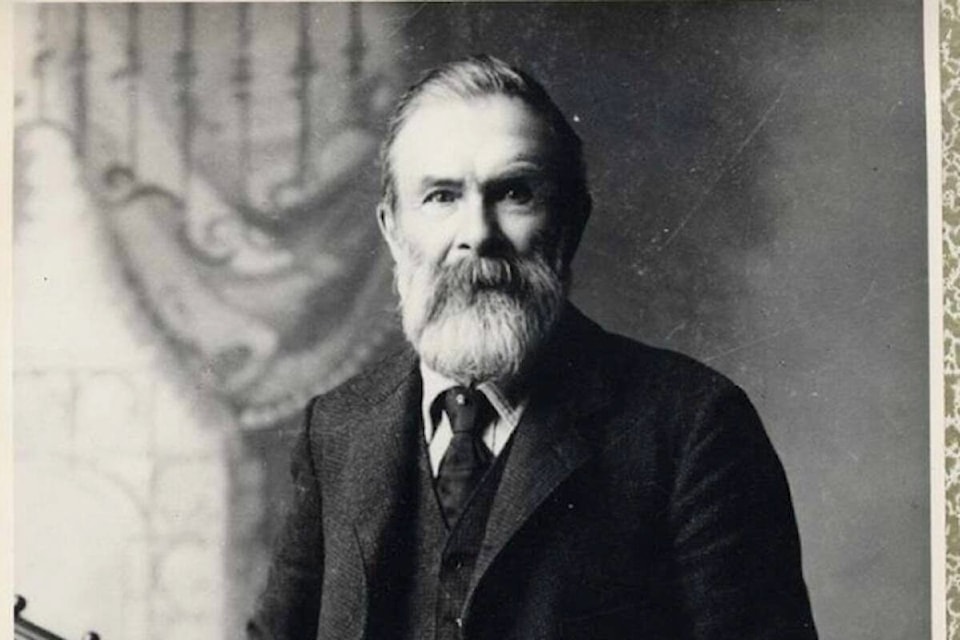A column by Bruce Uzelman
Fernie was founded on the potential of the emerging coal industry in 1898. William Fernie, a native of Scotland, arrived in B.C. in 1860 and prospected for gold for several years. Michael Phillips ventured from England to the Elk Valley, also in 1860. In 1873, Phillips embarked on a major gold prospecting trip. Instead, he discovered vast coal deposits, and the Crowsnest Pass.
Phillips shared his coal discovery with a disinterested William Fernie. Finally, years later, Fernie formed a syndicate to develop the coal deposits with Colonel James Baker (who would later found Cranbrook) and other investors. Fernie applied for a license to prospect for coal in 1887, and staked claims for promising deposits. It took a decade to raise the money to open the mine.
Fernie’s syndicate sold its claims to the Crowsnest Pass Coal Company (CPCC), a company formed in Montreal, in exchange for shares in the company worth $1million. Unfortunately, they soon lost control of the company to eastern investors. The company rapidly developed its first mine on Coal Creek in 1897, just east of the planned townsite of Fernie.
The CPCC owned the townsite. William Fernie surveyed the town of Fernie in 1898. He became the CPCC’s land commissioner, and sold both commercial lots along Victoria Avenue (later to become 2nd Avenue) and residential lots. Before 1899 ended, dozens of businesses lined Victoria Avenue.
Disaster struck the Coal Creek Mine in 1902. The company had made no effort to mitigate the coal dust, which was as deep as two feet in the mine. Routine blasting, on May 22, ignited the coal dust fouling the air and accumulated on the floor, resulting in a massive, lethal explosion. Trains carried the dead to town. One hundred twenty-eight men perished. CPCC’s ineptitude resulted in tragedy.
Nevertheless, by 1904, the new town had grown impressively. It boasted a department store, a drug store, grocery stores, a newspaper, many hotels, a brewery and much more. Fernie was a thriving community. Many immigrants from England, Ireland, France, Italy and Eastern Europe arrived to work in the mines. Forestry, another key industry and employer, quickly developed.
Fernie suffered devastating fires in both 1904 and 1908. Early morning, April 29,1904. A fire started in Richards General Store. In quick succession, it spread to Mitchell’s Taylor Shop, the Fernie Drug Store and the Victoria Hotel. The water system failed, incapacitating the fire fighters. Within hours the entire business district was wiped out. Sixty-five buildings on Victoria Avenue were obliterated.
The business district was a wasteland, but the residents were resilient. They quickly rebuilt. The townspeople convinced the CPCC to relinquish control of the townsite to a new city council, which was empowered to enforce building regulations. Fernie officially became a city.
Just four years later, it happened again. Fernie’s “Great Fire” began several days after a small bush fire outside the city started to burn. August 1, 1908. A strong wind fanned the flames. The fire burnt through a thick forest. The Elk River Lumber Company mill was directly in its path. The wind drove the fire onward. The mill and huge stocks of lumber were consumed, further fueling the inferno.
The fire jumped the Elk River and encircled the city. Soon all of Fernie was aflame. The fire fighters directed residents to a few safe stone buildings. All others were forced to flee the city. Both CPR and Great Northern Railway trains shuttled terrified escapees through the flames enveloping the tracks. At the Elk River they disembarked, so the trains could return for those still trapped within the city.
“The heat became so intense on the rocky point where we were left that the only way we could save our lives was by going into the water,” a survivor wrote. “The smoke was so suffocating and the heat was so intense that we all believed we could live but a few minutes.” Almost all on the rocky point survived. Only a few inside the city perished. The train crews courageously saved countless lives.
Again, after the fire, the residents displayed resiliency. Promptly, temporary buildings took shape. City council required all permanent buildings in the business district to be constructed of brick or stone. By 1910 Fernie was rebuilt, with a population of 6000. The city flourished during and after reconstruction. Coal mining and forestry supported the local economy for decades.
The elegant stone and brick buildings on 1st, 2nd and 3rd Avenues and elsewhere have survived more than a century, and distinguish Fernie today as they did in 1910.
William Fernie was a key figure in the development of the Elk Valley and, of course, founded the City of Fernie. He directed the construction of the eastern section of the Dewdney Trail in the 1860s, was instrumental in ushering the CPR across the Crowsnest Pass into Southern B.C. in the 1890s and spearheaded the development of the coal industry in mainland B.C.
He did not remain long in the town bearing his name. Intent on retiring, he built a stunning estate overlooking the ocean in Victoria.
____
Bruce Uzelman, based in Kelowna, holds interests in British Columbia history as wells as current political and economic issues.
Bruce had a career in small business, primarily restaurant and retail. He holds a Bachelor of Arts, Advanced from the University of Saskatchewan, with Majors in Political Science and Economics.
Contact: urban.general@outlook.com



